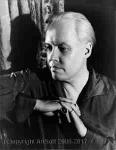Carl Van Vechten
Carl Van Vechten
Place: Cedar Rapids
Born: 1880
Death: 1964
Biography:
Carl Van Vechten was an American writer and artistic photographer who was a patron of the Harlem Renaissance and the literary executor of Gertrude Stein. He gained fame as a writer, and notoriety as well, for his novel Nigger Heaven. In his later years, he took up photography and took many portraits of notable people. Although he was married to women for most of his adult life, Van Vechten engaged in numerous homosexual affairs over his lifetime.
Born in Cedar Rapids, Iowa, he was the youngest child of Charles and Ada Van Vechten. :14 Both of his parents were well educated. His father was a wealthy and prominent banker. His mother established the Cedar Rapids public library and was musically talented. As a child, Van Vechten developed a passion for music and theatre. He graduated from Washington High School in 1898. After High School, Van Vechten was eager to take the next steps in his life, but found it difficult to pursue his passions in Iowa. He described his hometown as "that unloved town". In order to advance his education, he decided in 1899 to study at the University of Chicago. At the University of Chicago, he studied a variety of topics including music, art and opera. As a student, he became increasingly interested in writing and wrote for the college newspaper "University of Chicago Weekly". After graduating from college in 1903, Van Vechten accepted a job as a columnist for the Chicago American. In his column "The Chaperone" Van Vechten covered many different topics through a style of semi autobiographical gossip and criticism. During his time with the Chicago American, he was occasionally asked to include photographs with his column. This was the first time he was thought to have experimented with photography which would later become one of his greatest passions. Van Vechten was fired from his position with the Chicago American because of what was described as an elaborate and complicated style of writing. Some described his contributions to the paper as "lowering the tone of the Hearst papers". In 1906, he moved to New York City. He was hired as the assistant music critic at The New York Times. His interest in opera had him take a leave of absence from the paper in 1907, so as to travel to Europe to explore opera.
While in England he married his long-time friend from Cedar Rapids, Anna Snyder. He returned to his job at The New York Times in 1909, where he became the first American critic of modern dance. Under the leadership of Van Vechten's social mentor, Mabel Dodge Luhan he became engrossed in avant-garde art. This was an innovative type of art which explores new styles or subject matters and is thought to be well ahead of other art in terms of technique, subject matter and application. He also began to frequently attend groundbreaking musical premieres at the time, Isadora Duncan, Anna Pavlova, and Loie Fuller were performing in New York City. He also attended premiers in Paris where he met American author and poet Gertrude Stein in 1913 . He became a devoted friend and champion of Stein. He was considered to be one of Steins most enthusiastic fans. They continued corresponding for the remainder of Stein's life, and at her death she appointed Van Vechten her literary executor; he helped to bring into print her unpublished writings. :306 A collection of the letters between Van Vechten and Stein has also been published.
Van Vechten wrote a piece called "How to Read Gertrude Stein" for the arts magazine The Trend. In his piece Van Vechten attempted to demystify Gertrude Stein and bring clarity to her works. In his piece Van Vechten came to the conclusion that Gertrude Stein is a difficult author to understand and she can be best understood when one has been guided through her work by an "expert insider". He writes that "special writers require special readers".
The marriage to Anna Snyder ended in divorce in 1912 and he wed actress Fania Marinoff in 1914. Van Vechten and Marinoff were known for ignoring the social separation of races during the times and for inviting blacks to their home for social gatherings. They were also known to attend public gatherings for black people and even on occasion visit black friends in their homes.
Although Van Vechten's marriage to his wife Fania Marinoff, lasted for 50 years, there were often arguments between them over Van Vechten's affairs with men. Van Vechten was known to have romantic and sexual relationships with men, especially Mark Lutz.
Mark Lutz (1901–1968) was born in Richmond, Virginia and was introduced to Van Vechten by Hunter Stagg in New York in 1931. Lutz was a model for some of Van Vechten's earliest experiments with photography. The friendship lasted until Van Vechten's death. At Lutz's death, as per his wishes, the correspondence with Van Vechten, amounting to 10,000 letters, was destroyed. Lutz donated his collection of Van Vechten's photographs to the Philadelphia Museum of Art.
More...
Wikipedia link: Click Here














